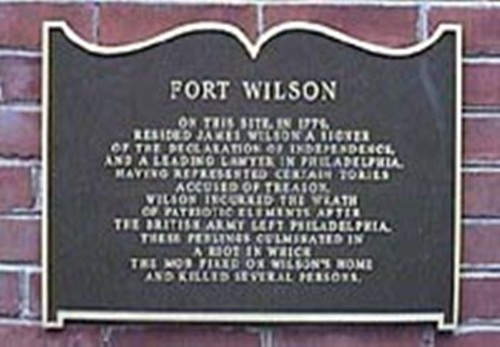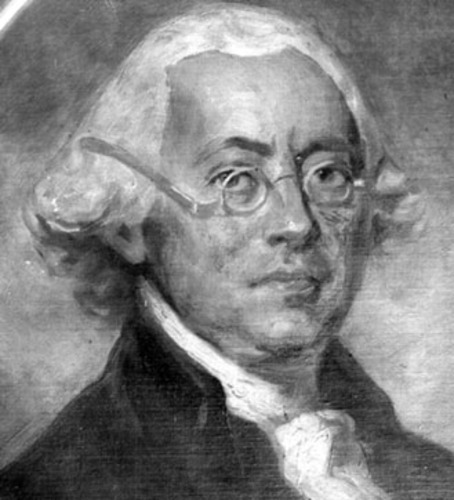Fort Wilson Riot October 4, 1779
BIRD Chronicles
Fort Wilson Riot
Terry Louis Linton © 1990
LINTON & BIRD Chronicles This Day in History Birthday and Anniversary
LINTON & BIRD Chronicles, Volume VI, Issue 2, Summer © 2011, ISSN 1941-3521
Some of our relives taking part in the “Fort Wilson Riot” were Jeff August “Gus” BIRD’s (1893-1954) 3rd great-granduncle James WILSON (1742-1798); his 3rd great-grandfather, Colonel Mark BIRD (1739-1812); his 3rd great-granduncle, Colonel William BIRD (1757-1812); his 3rd great-granduncle Lieutenant James BIRD (1759-1781); his 3rd cousin one removed Lieutenant Colonel James ROSS (1753-1708)
James WILSON’s home was located at the southwest corner of Third and Walnut Streets in Philadelphia. “It became a flash point for Philadelphians divided by politics and class. The militia attack on Fort Wilson occurred in the wake of conflict over the Pennsylvania Constitution of 1776, rising inflation, and the recent departure of the British Army. Wilson had come to symbolize the complicated politics of Philadelphia during the American Revolution”.
The riot began on October 4, 1779, after the British Army had abandoned the City of Philadelphia. Lawyer, Judge and Congressman James Wilson (1742-1798) had successfully defended at trial 23 people from property seizure and exile by the radical government of Pennsylvania.
Accoring to David Reader, who teaches history at Camden Catholic High School and was the recipient of the James Madison Memorial Fellowship in 2007. Copyright 2014, Rutgers University:
"A large number of militiamen gather at Burns Tavern on Tenth Street between Race and Vine Streets to take action against any man associated with profiteering and sympathetic to the British. Headed by Captain Ephraim Faulkner, the militia called on Charles Willson Peale (1741-1827) to lead their march through the city to arrest and detain their enemies. As some cried out, “Get Wilson,” Peale tried but failed to persuade the militia to abandon the plan. The militia captured four prominent merchants and forcefully marched them through the streets of Philadelphia in a display of public humiliation."
On October fourth, "A mob whipped up by liquor and the writings and speeches of Joseph Reed, President of Pennsylvania's Supreme Executive Council, marched on Congressman Wilson's home at Third and Walnut Streets. Wilson and 35 of his colleagues, barricaded themselves in his home, later nicknamed Fort Wilson. In the fighting that ensued, six died, and 17 to 19 were wounded. The city's soldiers, the First Troop Philadelphia City Cavalry and Baylor's 3rd Continental Light Dragoons, eventually intervened and rescued Wilson and his colleagues. The rioters were pardoned and released by Joseph REED".
Accoring to "To avoid being captured by the militia, Wilson and other members of the Republican Society barricaded themselves inside Wilson’s house. The militia stopped near Wilson’s house when Captain Robert Campbell (1753-79), who was inside, opened a window and either shouted to them to continue marching or shouted and fired his pistol at the militia. Storming the doors, the militiamen set fire to the first floor and killed Campbell before being turned away by the men inside. The arrival of Joseph Reed (1741-85), President of the Pennsylvania Supreme Executive Council, and the City Troop of Light Horse ended the attack on Fort Wilson. Four militiamen, one free Black youth (who joined the militia’s march), and Captain Campbell were killed, and fourteen militia and three men from inside the house were wounded.
The arrest of several militiamen increased the tension throughout the city and surrounding areas. Wilson fled the city to Morris’s country estate until October 19, 1779, when he returned to the city at night. The Pennsylvania Assembly acted quickly to quell the tension between the classes through legislation that provided flour to the families of the militia and re-emphasized the enforcement of the laws pertaining to military service. In March 1780 the Executive Council passed an act pardoning all involved in the attack on Fort Wilson."
Above photo: Historical marker on James Wilson,s home located at located at the southwest corner of Third and Walnut Streets in Philadelphia. photo by Terry l. Linton ........................................Below etching: James WILSON (1742-1798)
Below watercolor: James WILSON (1742-1798) Home, this watercolor painted by Ridgway Evans in 1888. (Historical Society of Pennsylvania)
Linton Research Fund, Inc., HOME PAGE
Past BIRD Articles from the BIRD Chronicles
Past LINTON Articles from the LINTON Chronicles
Who is having a Birthday or a Anniversary today
The LINTON & BIRD Chronicles on Facebook
"Thanks for Visiting, come back when you can stay longer" Terry Louis Linton © 2007 ![]()
Copyright Linton Research Fund Inc.,© 1987-2017


_500x353.jpg)